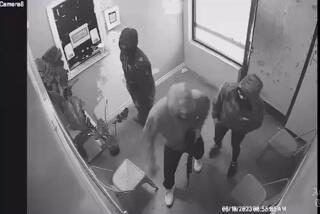Crime Analysts Follow Trail of Information
- Share via
Dana Trottier has tracked many trends in her 11 years as a crime analyst with the Ventura County Sheriff’s Department, but none as unusual as the case of a man suspected of placing sexually explicit and derogatory notes in the purse or pocket of at least 30 unsuspecting female shoppers at The Oaks mall.
“He was targeting Jewish women primarily, or those with names that could be construed as being Jewish,” Trottier said. The handwritten messages, often anti-Semitic, were placed in the purse or coat pocket of the women when they weren’t looking. “They were definitely upsetting to the women. And I believe the 30 who reported it were probably just the tip of the iceberg,” Trottier said.
Through interviews with the victims and the data Trottier gleaned from those interviews, deputies contacted several suspects. Nobody has been arrested in the case, but the notes have stopped.
Police say that case is just one of many successes that can be credited to crime analysis, an aspect of law enforcement that is becoming more important as police departments get more involved in crime prevention, according to experts.
Daily, Trottier studies an inch-thick stack of police reports, looking for trends that will help solve cases or help prevent crime by providing officers, and the public, with information about crime trends in a specific area.
Unlike a criminalist who scours a crime scene for physical evidence, the crime analyst uses information about crime to predict criminal behavior. In his book “Crime Analysis: From First Report to Final Arrest,” author Steven L. Gottlieb writes that the purpose of analysis is to reduce and prevent crime in a cost-effective manner.
“We’re armed with data and data is our tool,” said Trottier, who holds a master’s degree in sociology and a bachelor’s degree in behavioral science.
On Tuesday at the Sheriff’s Department’s Camarillo station, Trottier led a discussion among 10 analysts from Ventura and Los Angeles counties on how technology is helping the crime analyst, and how law enforcement agencies can share information on crime and criminals.
The analysts agreed that criminals are becoming more mobile. “Crooks don’t just stay in one place, they cross jurisdictional lines,” said Trottier.
Knowing when a particular type of crime is likely to take place and passing that data along to officers can help reduce crime, said Louise Ramirez, a crime analyst with the Los Angeles County Sheriff’s Department’s Lost Hills/Malibu Station. “We know that in Malibu in the summer, our auto burglaries skyrocketed. But we put together our beach team and put them out there, and the auto burglaries went down,” Ramirez said.
One of the tools crime analysts are using more than ever before is the computer. “The computer is changing the way we track crime and the way we are keeping track of criminals,” said Cheryl Garcia, an Oxnard Police Department community services officer.
One technique used by crime analysts is profiling, in which the analyst predicts crime by knowing how a criminal thinks and acts. Trottier is among three local crime analysts who are completing a state university course in profiling by studying nine previous homicide cases.
“Knowing the criminal’s MO is very important. What works in a previous offense will probably work in the next instance,” she said.
As in most police work, public cooperation is a key.
“If they don’t report it, we can’t analyze it, and the police can’t do anything about it,” Trottier said.
More to Read
Sign up for Essential California
The most important California stories and recommendations in your inbox every morning.
You may occasionally receive promotional content from the Los Angeles Times.










